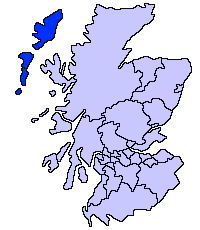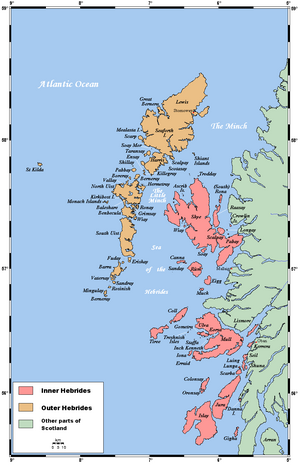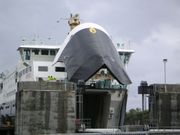Outer Hebrides
2007 Schools Wikipedia Selection. Related subjects: Geography of Great Britain
- Western Isles redirects here. The term "Western Isles" is becoming more common since its adoption as the English language name of the local government area. A traditional usage referring to the whole of the Hebrides can still occasionally be heard in Scottish speech
The Outer Hebrides or Western Isles ( officially known by the Gaelic name, Na h-Eileanan Siar) comprise an island chain off the west coast of Scotland. They form part of the Hebrides, separated from the Scottish mainland and from the Inner Hebrides by the stormy stretch of water known as the Minch and the Little Minch. Most communities in the Outer Hebrides use the Scottish Gaelic language. The name for the UK Parliament constituency covering this area is Na h-Eileanan an Iar, whilst the Scottish Parliament constituency for the area continues to be officially known as Western Isles although it is almost always written as Western Isles (Eilean Siar). The islands were known as Suðreyjar ("Southern Islands"; cf. Suðrland) under Norwegian rule for about 200 years until sovereignty was transferred to Scotland in the Treaty of Perth in 1266, which followed the Battle of Largs three years earlier. Colloquially they are sometimes referred to collectively as An t-Eilean Fada or "The Long Island"; Na h-Eileanan a-Muigh (the Outer Isles) is also heard occasionally in Scottish Gaelic as is their proper Gaelic name Innse Gall.
Local government
The Western Isles have been a unitary council area since 1975. In most of the rest of Scotland, however, similar unitary councils were not established until 1996. Since then the islands have formed one of the 32 unitary council areas which now cover the whole of Scotland. The Western Isles council is officially known by its Gaelic name, Comhairle nan Eilean Siar, and known locally simply as 'the Comhairle' or 'a Chomhairle', having changed its name under the Local Government (Gaelic Names) (Scotland) Act 1997. The council has its base in Stornoway on Lewis.
Lewis is in the north of the island group and forms part of the county of Ross-shire. The rest of the group, including Harris, is part of Inverness-shire. Between 1890 and 1975 administration was split, by the Lewis-Harris boundary, between the county councils of Ross and Cromarty (which covered Ross-shire and Cromartyshire) and Inverness-shire.
The Western Isles is a member of the International Island Games Association.
Religion
The Western Isles (particularly Lewis) have been described as the last bastion of fundamentalist Calvinism in Britain with large numbers of inhabitants belonging to the Free Church of Scotland or the still more conservative Free Presbyterian Church of Scotland. Services in the Free Church, the Free Presbyterian Church and some congregations of the Church of Scotland do not use instrumental music or any songs other than the metrical Psalms.
It has also generally been considered unacceptable for people to appear in church improperly dressed, although this is slowly changing. Violations of this nature might include the failure by women to wear a hat, or trousers being worn instead of a skirt, or the wearing by worshippers of either sex of informal clothing such as jeans. The local council refused in December 2005 to conduct ceremonies for same-sex couples wishing to register under the Civil Partnerships Act 2004.
In 2006 controversy arose over the decision of a local ferry company to sail to Harris on the Sabbath .
The predominantly Roman Catholic islands of South Uist, Barra, and Benbecula are however less strict in their Sunday observance.
Islands
The main islands form an archipelago, which with their smaller surrounding islands are sometimes known poetically as the Long Isle. The major islands include Lewis and Harris, North Uist, Benbecula, South Uist and Barra.
Populated islands
| Island | Population (2001 census) |
| Lewis and Harris | 19,918 |
| South Uist | 1,818 |
| North Uist | 1,271 |
| Benbecula | 1,219 |
| Barra | 1,078 |
| Scalpay | 322 |
| Great Bernera | 233 |
| Grimsay | 201 |
| Berneray, North Uist | 136 |
| Eriskay | 133 |
| Vatersay | 94 |
| Baleshare | 49 |
| Grimsay, South East Benbecula | 19 |
| Flodda, Benbecula | 11 |
Unpopulated islands
The unpopulated islands include:
- Barra Isles, Boreray
- Calvay, Campay
- Eilean Chaluim Chille, Eilean Iubhard, Eilean Kearstay, Eileanan Iasgaich, Ensay
- Fiaray, Floday, Flodday, Floddaybeg, Floddaymore, Fuday, Fuiay
- Gighay, Gilsay, Groay
- Hellisay, Hermetray
- Killegray, Kirkibost
- Lingay, Little Bernera
- Mealasta Island, Mingulay
- Opsay, Oronsay, Orosay
- Pabbay near Harris, Pabbay Mór
- Ronay
- Seaforth Island, Scaravay, Scarp, Scotasay, Shiant Islands, Shillay, Soay Beag, Soay Mór, Stockinish Island, Stromay, Stuley, Sursay
- Tahay, Taransay
- Vacsay, Vallay, Vuia Beg, Vuia Mór
- Wiay
Small islands and island groups pepper the North Atlantic surrounding the main island group:
To the west lie the Monach Islands, Flannan Isles, St Kilda and Rockall, in increasing order of distance. The status of Rockall as part of the United Kingdom remains a matter of international dispute.
To the north lie North Rona and Sula Sgeir, two small and remote islands. Not often included as part of the Outer Hebrides, they nevertheless come under the administration of the Western Isles district.
The Hebrides under Norse control
The Outer and Inner Hebrides came under Norse control and settlement before the 9th century AD. The Norse control of the Hebrides was formalized in 1098 when Edgar of Scotland formally signed the islands over to Magnus III of Norway. The Scottish acceptance of Magnus III as King of the Isles came after the Norwegian king had conquered the Orkney Islands, the Hebrides and the Isle of Man in a swift campaign earlier the same year, directed against the local Norwegian leaders of the various islands. By capturing the islands Magnus III subdued the Norsemen who had seized the islands centuries earlier and imposed a more direct royal control.
The Norwegian control of both the Inner and Outer Hebrides would see almost constant warfare until being ultimately resolved by the partitioning of the Western Isles in 1156. The Outer Hebrides would remain under the Kingdom of Mann and the Isles while the Inner Hebrides broke out under Somerled, the Norse-Celtic kinsman of both Lulach and the Manx royal house. Although the Inner Hebrides, from 1156 known as the Kingdom of the Hebrides, was still nominally was under the sovereignty of Norway, the leaders were Scottish in language and culture rather than Norse.
After his victory of 1156, Somerled went on two years later to seize control over the Isle of Man itself, and become the last King of the Isle of Man and the Isles to rule over all the islands the kingdom had once included. After Somerled's death in 1164 the rulers of Mann would only be in control of the Outer Hebrides.
As a result of the 1266 Treaty of Perth the Outer Hebrides, along with the Isle of Man, were yielded to the Kingdom of Scotland.
Ferries
Scheduled Ferry services between the Outer Hebrides and the Scottish Mainland and Inner Hebrides operate on the following routes:
- Oban to Castlebay on Barra and Lochboisdale on South Uist
- Uig on Skye to Tarbert on Harris
- Uig on Skye to Lochmaddy on North Uist
- Ullapool to Stornoway on Lewis
- Tiree to Castlebay, Barra (summer only)
Other ferries operate between some of the islands.


